
Features
Community
Event reports
More than plain dots and stripes
Advancements in deco glass technology give architects more options.
June 16, 2009 By Pat Bolen
The decorative business in the last five years has certainly grown
leaps and bounds,” says Bill Marchitello, director of marketing and
business development for Prelco, who was one of several companies Glass
Canada spoke to about trends in the ‘deco’ glass industry.
The decorative business in the last five years has certainly grown leaps and bounds,” says Bill Marchitello, director of marketing and business development for Prelco, who was one of several companies Glass Canada spoke to about trends in the ‘deco’ glass industry.
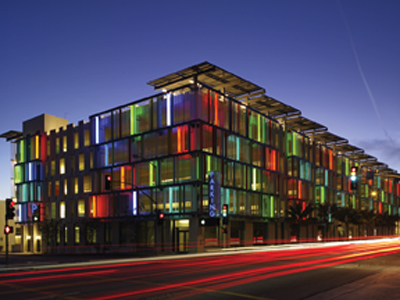 |
|
Deco glass represents a good portion of what Prelco does, says Marchitello. “We’re in the architectural market rather than residential and deco glass is certainly a big part of architecture in the areas we cover. Things are positive and it’s usually high end; the majority of what we do is still ceramic frit or opaci coat, which is full coverage paint. We do a fair amount of silk screening, which is design built and very often it’s custom work that architects are designing and requiring.”
Marchitello notes the Glass Association of North America (GANA) now has a deco-division which has a large membership in comparison to its other divisions. “It grew fast,” says Marchitello.
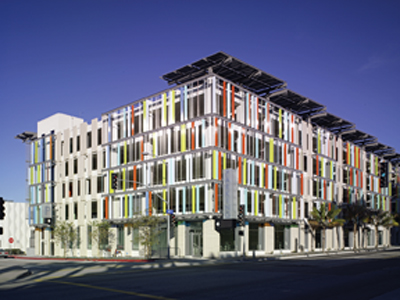 |
|
| The combination of six translucent pantone colours applied to 1100 textured u-glass panels and neon tubes creates an impressive visual effect for the Santa Monica Parking Garage in California. At night the entire structure glows vibrantly throughout the exterior glass. Designer: Moore Ruble Yudell Architects + Planners. Photos courtesy of Grosvenor Uber Materials. |
“Technology creates demand,” he adds. “There is still a demand for products such as silk screening, ceramics and silicone paints, but I still see a steady growth in the expressions…and there are other technologies such as decals on glass that seem to be gathering steam.”
Marchitello notes “that when architects think about performance, they think about deco glass…whether it’s plain lines or dots, or the non-standard patterns, they opt for that very quickly rather than a tint.”
Regarding where the industry is going, Marchitello says the trend is heading towards specialty glass. “I see a lot more colour, some of it is going on in the interior, which is a little surprising considering the cost factors, but they’re doing everything with it.”
Prelco is also doing more glass stair work, which Marchitello says isn’t new, but is becoming more popular after being sporadic in the past.
Unique applications, such as glass stairs, present more of a technical challenge for the product to stand up. “Every job seems to be specially designed, so you’ve got the design factors to worry about.”
Describing a project Prelco is working on at the Dorval airport hotel, Marchitello says they are doing a cubicle with glass floors.
“It’s three layers of 10 millimeter laminated with Sentry Glass Plus and it’s capped at the end with a stainless steel U-channel. And the way it’s trapped in that U-channel, it’s almost like it’s one piece. It fits, not over, but almost into the glass. So there are different challenges there because if you put a U-channel over the glass, then the glass isn’t flat. It has to end up the same thickness as the glass, so there has to be notches cut out in the glass,” he says.
“Part of the challenge is to keep the cost reasonable but yet when somebody wants something, they want it that way and you have to figure a way to do it without tripling the cost.”
From the windows at a Chicago hospital with a Frank Lloyd Wright influence, to an all-glass garage and a department store in Mexico City, Joseph Aigner, owner of Artistic Glass in Toronto, says what sets Artistic apart is its handcrafted religious work, which it considers to be its specialty. “We are not very motivated with a standard design that you repeat 100,000 times,” says Aigner, adding they are currently putting together a plan for a home in Toronto that includes a bridge on the second floor that is 50 feet long and all crystal starfire glass.
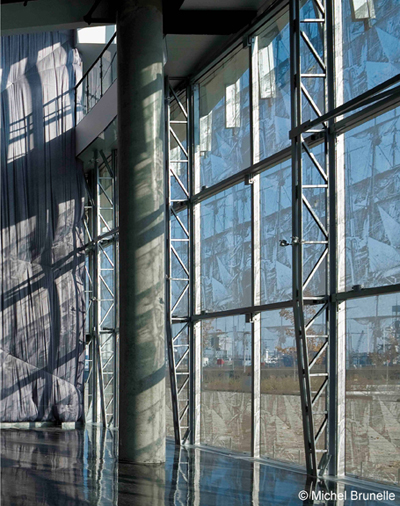 |
|
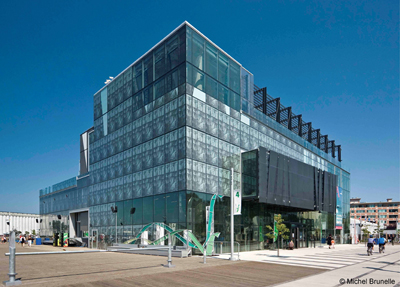 |
|
| Prelco’s Espace 400e project in Quebec City uses sealed units with a ceramic frit silk-screened pattern on #2 and #4 surface. It was designed by an architect consortium of Dan Hanganu and Côté Leahy Cardas and the glazing was done by Gamma Industries. The silkscreened pattern shows the first French vessels landing in Quebec City. The architect supplied Prelco with a black and white image, which has been converted into dot pattern, burned on a silkscreen and then printed on the glass. Photos courtesy of Prelco. |
While Artistic has European influences, Aigner says it is not difficult combining the old world style with North American design. “If it’s baroque, we do baroque, if it’s gothic we work in that. But we combine a lot with a modern structure…it works very well because one is realistic and the other has a flair of modern form.”
Despite its old world influences, Aigner says the company is always challenging itself with new methods, such as with its fused glass, which involves melting glass together to make glass furniture and tables.
Cathie Saroka, marketing director for Goldray Industries in Calgary, says the company does exclusive decorative glass. “We do all types of decorative glass, including interior and exterior.
“We know that decorative glass can be used in place of other, more traditional building materials and it gives more variety and can be used in many different applications.”
Saroka says the market has expanded for decorative glass, even in the last couple of years. “We’ve seen a huge increase in the number of architects and designers and glazing contractors that are willing to use it.”
Saroka says since GANA opened the decorative division, two or three years ago, the association has been doing both marketing and education about decorative glass, which has had a huge increase on the use of the product.
“Everything follows demand,” says Saroka and as more people use and understand deco glass, with the different things that can be done with it, technological advances are moving hand-in-hand, with the increased demand.
In the past couple of years, Saroka says printed interlayers have come a long way, so has applying ceramic enamels to glass digitally. “Both of those allow more customization for a reasonable cost. Before, if you had customization, you’d have to pay huge upfront costs to be able to make something special in your building. But now with the new technology that allows you to print individual pieces, either using interlayers or ceramic frit, that’s had a big impact on what architects can do and that isn’t just plain old dots and stripes.”
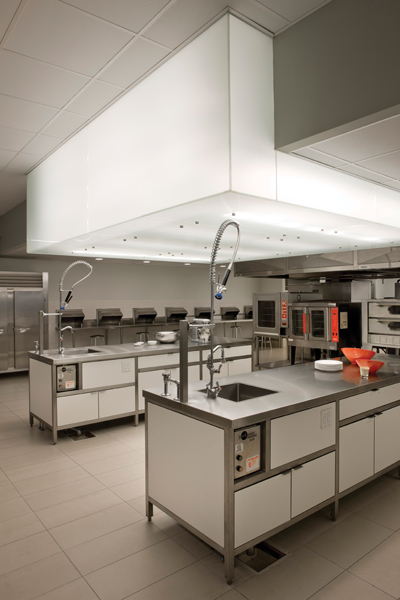 |
| For a light diffuser application at Sysco Corporation in Houston, Texas, Goldray Industries supplied decorative laminated glass with a full flood application of silkscreened ceramic frit, which was glazed by Lakeview Glass & Mirror. Photo courtesy of Goldray Industries. |
The most well known of the interlayers is Sentry Glass, says Saroka. “It’s a great product…we have our own interlayer, we call it technographic interlayer, and it’s the same principle. You are able to print directly onto an interlayer or a film that gets laminated in between two pieces of glass, so the print is protected on both sides by glass and it can also be made into safety glass by laminating it.”
Increased confidence in the safety of decorative glass has also led to its increased use, says Saroka. “It used to be that people didn’t want to use it because they were worried about things like maintenance or safety or installing the product, but there has been so much more education and the actual products have moved ahead so much, those things are not really a concern anymore when you’re dealing with credible companies.”
Canadians are getting more used to the idea of using colour in buildings, says Danny Yehia, director of sales for Grosvenor North America. “We work very closely with designers and architects, and especially with residential interior designers and we’re seeing a lot of people go in that direction and we’ve found that it’s affordable. Interior designers really like it,” says Yehia.
“The biggest shift is going to be towards more eco coatings,” he adds. “Most people use a solvent-based coating and that is going to be the biggest change, as far as more custom colours and more custom options. Metallics, pearls and some of the more exotic colours that you’ll get, that’s what we’ve noticed.”
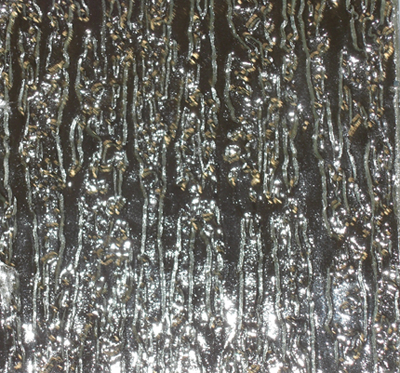 |
|
| The new Sterling Collection by SPS Glass & Metals is an example of the design and pattern possibilities being applied to decorative glass products. Photo courtesy of SPS Glass & Metals.
|
Yehia says Grosvenor has a proprietary colour system coating that is a modified automotive coating specially formulated to give great adhesion to glass. “This is very difficult so we’ve created a system where we can permanently attach it, so it’s molecularly bonding and it doesn’t come off or fade.”
While Grosvenor has had the system for six years, it was developed in the late 1980s. “It’s been proven and used worldwide in Australia, Europe and throughout North America.
“It was originally big in Europe and Australia and usually they’re a little bit ahead of us as far as design trends and now it’s really starting to come into prominence in North America. More people are starting to use backsplashes, especially now with the economy because it’s very affordable, easy to clean and timeless.”
Grosvenor also does a lot of pattern glass, which Yehia says has been around a long time. “There are always new textures being created and just like fashion, it kind of comes back to the beginning. So you’re seeing some very cool, sort of retro patterns around from the 60s and 70s that are making a big comeback. But there are so many different textures. There’s linear and non-linear textures and some that are designed to look like cast glass, that is made by taking glass sheets and putting it on a mould and then heating up the glass to form into the shape of the mould. Cast glass, which was really big in the last decade, is out now and people are going towards rolled textured glass, which is less expensive and you get a lot more options.”
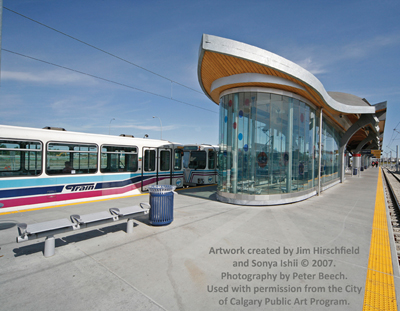 |
|
| Goldray Industries used technographic interlayers for the McKnight/Westwinds transit shelter in Calgary, Alta., which shows historic and current photographs of immigrants that settled the city’s northeast quadrant. Glazier was Alpine Glass. Artwork created by Jim Hirschfield and Sonya Ishii, 2007. Photography by Peter Beech. Used with permission from the City of Calgary Public Art Program.
|
Grosvenor is also moving ahead with some newer colour options, such as colour shifting and Yehia says metallics are the trend they are seeing, “metallic silvers are in vogue.”
Large format printing is what customers are looking for, says Roland Rossman, project leader with Garibaldi Glass in Burnaby, who says while everyone in North America can do 48 inches, “it’s 84 inches, that’s where it gets difficult to make it stand out and that is what they are looking for. They want to have that unimpeded view.” Rossman says large multicolour projects require a careful planning process, which is what Garibaldi is being sought out for. “We have a project management team. Once you screen something and start layering it, the costs increase significantly, so if you make a mistake, that’s an expensive mistake.”
Rossman says Seattle’s Olive 8 condo project is a good example of the planning process, which saw a curtainwall covering two elevations of the building with 356 fritted and laminated panels, with each panel measuring 65 by 106 inches. “It’s a rolling olive and each panel is unique. There were 356 panels and not one error.”
Rossman says architects are also starting to realize what companies like Garibaldi can do. “They find it quite surprising; they didn’t know we had the ability.”
“We’re very good at complex,” says Rossman, but adds the company does not have any product it considers to be unique. “We’re good at working with architects and designers…we bring them together. They push the envelope and it makes us innovate.”
While Vancouver is unique, says Rossman, with an emphasis on promoting “light and airy, Canada is still a little behind places like Europe, with the buildings here a little more intimate. We’ll get there, we’re just catching up.”
*Pat Bolen is a professional writer based in Ontario.
Print this page
Leave a Reply